#java full stack developer
Explore tagged Tumblr posts
Text
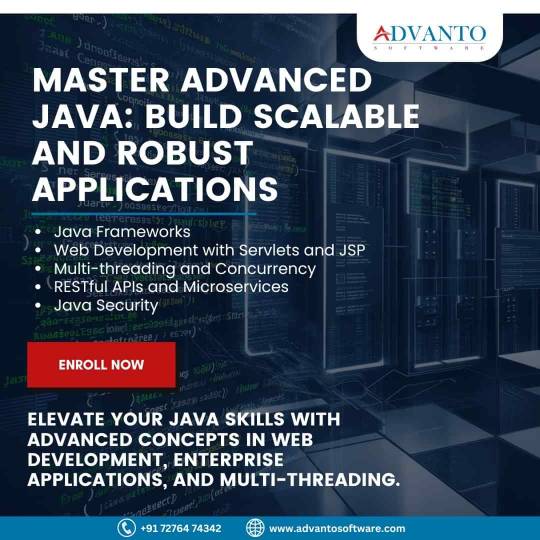
Level up your Java expertise! Master advanced concepts to build scalable, robust applications. From web dev to microservices, take your skills to new heights. Enroll now and become a Java pro!
Visit www.advantosoftware.com or call +91 72764 74342 to transform your data into actionable intelligence. Don't just follow trends—set them with Advanto!
3 notes
·
View notes
Text
The Future of Full Stack Java Development
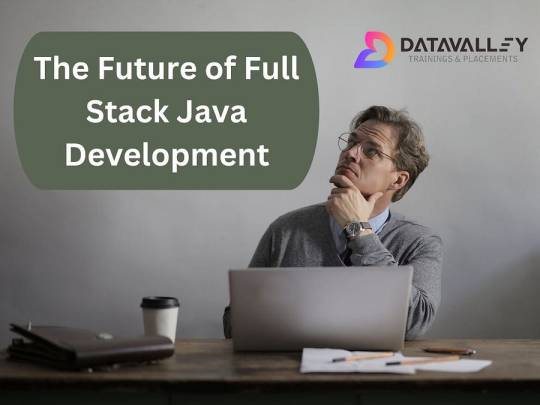
Full-stack developers, also known as “jack of all trades,” are in high demand in India. They are capable of carrying out the duties of numerous professionals. They earn good money and have many job opportunities with rewarding experiences because of their diverse skills. Full-stack Java programming has a bright future because its popularity is growing and will continue to grow in the coming years.
It’s well known that full-stack developers are proficient in both server-side and client-side programming. They are the professionals who carry out the responsibilities of backend and frontend developers. Despite not always being regarded as specialists, their abilities enable them to handle development tasks with ease. All firms look forward to having a brilliant full-stack developer as a future developer for a number of reasons. They handle a variety of technologies, which enables them to manage more project facets than the typical coder.
An experienced web developer who primarily works with Java programming is known as a Java full-stack developer. The front end, back end, and database layer are the three levels of code that these web developers build. The web development teams are frequently led by full-stack Java engineers, who also assist in updating and designing new websites. Because there is a great demand for Java full-stack developers. Many institutions have seized the opportunity by providing well-thought-out Java full-stack developer courses. You may study full-stack development quickly and become an expert in the area with the aid of these courses.
Java Full Stack Development by Datavalley
100% Placement Assistance
Duration: 3 Months (500+ hours)
Mode: Online/Offline
Let’s look into the future opportunities for full-stack Java professionals in India.
4 things that will Expand the Future Purpose of Java Full-Stack Developers
The Role of a Full-Stack Developer
Full-stack developers work on numerous tasks at once. They need to be extremely talented and knowledgeable in both front-end and back-end programming languages for this. JavaScript, CSS, HTML, and other frontend programming languages are essential. When creating new websites or modifying old ones, Java is a key programming language used by Java full-stack developers. However, backend programming languages consist of .Net, PHP, and Python depending on the projects. The full stack developers are distinguished from other developers by their proficiency and understanding of programming languages. With the availability of the finest Java full stack developer training, students may now easily master a frontend programming language like Java. The full-stack developer is more valuable and in demand when they are knowledgeable in multiple programming languages.
Responsibilities of a Full-Stack Developer
Functional databases are developed by full-stack developers. It creates aesthetically pleasing frontend designs that improve user experience and support the backend. The entire web-to-web architecture is under the control of these full-stack developers. They are also in charge of consistently maintaining and updating the software as needed. The full-stack developers bear the responsibility of overseeing a software project from its inception to its finalized product.
In the end, these full-stack developers also satisfy client and technical needs. Therefore, having a single, adaptable person do many tasks puts them in high demand and increases their potential for success in the technology field. Through extensively developed modules that expand their future scope, the Java full-stack developer course equips students with the skills necessary to take on these tasks.
The full-stack developer salary range
Full-stack developers are among the highest-paid workers in the software industry. In India, the average salary for a full-stack developer is 9.5 lakhs per annum. The elements that determine income typically include experience, location of the position, company strength, and other considerations. A highly skilled and adaptable full-stack developer makes between 16 and 20 lakhs per annum. Full-stack engineers get paid a lot because of their extensive skills, they can handle the tasks of two or three other developers at once.
By fostering the growth of small teams, preventing misunderstandings, and cutting the brand’s operating expenses, these full-stack developers perform remarkable work. Students who take the Java full-stack developer course are better equipped to become versatile full-stack developers, which will increase their demand currently as well as in the future in the industry.
Job Opportunities of Java Full Stack Developers
The full-stack developers are knowledgeable professionals with a wide range of technological skills. These competent workers are conversant with numerous stacks, including MEAN and LAMP, and are capable of handling more tasks than a typical developer. They are skilled experts with a wealth of opportunities due to their extensive understanding of several programming languages.
Full-stack developers are in high demand because they can work on a variety of projects and meet the needs of many companies. The full-stack Java developer course helps students build this adaptability so they can eventually become the first choice for brands searching for high-end developers.
As a result, these are a few key factors improving the future prospects of Java Full Stack developers in India. They are vibrant professionals who are in high demand due to their diverse skill set and experience, and they are growing steadily. The Java full stack developer course can help students hone their knowledge and abilities to succeed in this industry.
Datavalley’s Full Stack Java Developer course can help you start a promising career in full stack development. Enroll today to gain the expertise and knowledge you need to succeed.
Attend Free Bootcamps
Looking to supercharge your Java skills and become a full-stack Java developer? Look no further than Datavalley’s Java Full Stack Developer bootcamp. This is your chance to take your career to the next level by enhancing your expertise.
Key points about Bootcamps:
It is completely free, and there is no obligation to complete the entire course.
20 hours total, two hours daily for two weeks.
Gain hands-on experience with tools and projects.
Explore and decide if the field or career is right for you.
Complete a mini-project.
Earn a certificate to show on your profile.
No commitment is required after bootcamp.
Take another bootcamp if you are unsure about your track.

#dataexperts#datavalley#data engineering#data analytics#dataexcellence#business intelligence#data science#power bi#data analytics course#data science course#java developers#java full stack bootcamp#java full stack training#java full stack course#java full stack developer
2 notes
·
View notes
Text
Top Challenges Faced by Java Full-Stack Developers and How to Overcome Them

Java full-stack development is a rewarding career path, but like any profession, it comes with its own set of challenges. From staying updated with evolving technologies to managing multiple layers of application development, developers often find themselves juggling diverse responsibilities.
This blog highlights five common challenges faced by Java full-stack developers and offers actionable strategies to overcome them effectively.
1. Keeping Up with Rapidly Evolving Technologies
The Challenge
The tech landscape is constantly changing, with new frameworks, tools, and practices emerging regularly. For full-stack developers, staying relevant means keeping pace with both front-end and back-end advancements.
How to Overcome It
Regular Learning: Dedicate time to learn new tools and frameworks. Follow industry blogs, attend webinars, and take up online courses.
Join Developer Communities: Platforms like GitHub, Stack Overflow, and Reddit can provide insights into trending technologies.
Experiment: Build side projects to practice new skills and stay updated.
2. Managing Front-End and Back-End Responsibilities
The Challenge
Balancing both front-end and back-end development can be overwhelming, especially for developers transitioning from specialized roles.
How to Overcome It
Plan Your Workload: Break tasks into smaller, manageable chunks and tackle one layer at a time.
Use Full-Stack Frameworks: Tools like Spring Boot and Next.js simplify the integration of front-end and back-end components.
Collaborate: Work closely with team members to share the workload effectively.
3. Ensuring Application Scalability and Performance
The Challenge
Building applications that perform well under heavy load while maintaining scalability is a significant challenge for full-stack developers.
How to Overcome It
Optimize Code: Follow best practices in coding to reduce resource consumption.
Database Design: Use indexing, caching, and optimized queries for better performance.
Load Testing: Test your application under simulated high-traffic scenarios to identify bottlenecks.
4. Debugging Complex Applications
The Challenge
Debugging can be daunting when issues span across multiple layers of the stack, from front-end interactions to server-side processing and database queries.
How to Overcome It
Use Debugging Tools: Tools like Chrome DevTools for front-end debugging and Eclipse/IntelliJ for Java back-end debugging are invaluable.
Log Strategically: Implement detailed logging mechanisms to track errors and system behavior.
Start Simple: Debug individual components before testing the full stack.
5. Balancing Development with Testing
The Challenge
Full-stack developers are often pressed for time, leading to insufficient testing and quality assurance for applications.
How to Overcome It
Automate Testing: Use tools like JUnit for back-end testing and Selenium for front-end testing.
Test Early: Implement unit and integration tests during development to catch bugs early.
Adopt CI/CD: Continuous integration and delivery pipelines help automate testing and deployment processes.
Conclusion
While Java full-stack development is a demanding role, understanding and addressing its challenges can make your journey smoother and more productive. Staying proactive with learning, collaborating effectively, and adopting best practices are key to overcoming these hurdles.
Remember, every challenge is an opportunity to grow. Tackle these obstacles head-on, and you’ll emerge as a more skilled and confident Java full-stack developer!
0 notes
Text
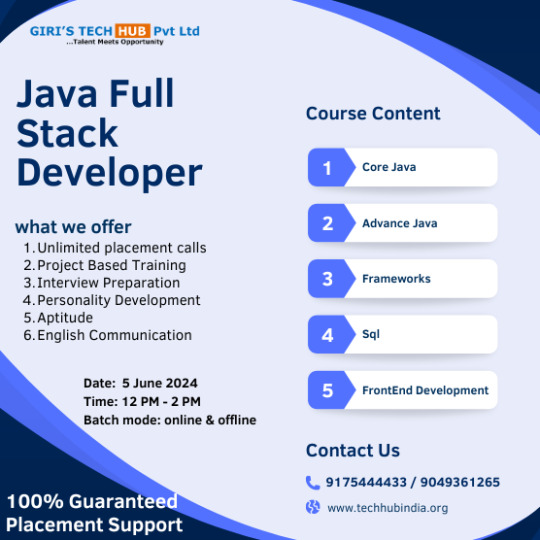
Giri's TechHub is most like Classes In Pune for java full stack developer, we provide IT Courses In Pune With 100% Placement Support, Call for Details : +91 9175444433.
#full stack java developer course#java full stack developer#javaprogramming#java developers#java#it classes in pune#course
1 note
·
View note
Text

"Empower Your Tech Journey: Comprehensive Training in Python Full Stack, Java Full Stack, DevOps, and Microsoft Azure"
Embark on a transformative journey into the heart of modern tech with our comprehensive training programs. Whether you're diving into Python Full Stack development, mastering Java Full Stack technologies, delving into the world of DevOps, or harnessing the power of Microsoft Azure, our expert-led courses offer a roadmap to success. Gain hands-on experience, learn industry best practices, and emerge equipped to tackle real-world challenges head-on. Join us and unlock the potential of your tech career today.
0 notes
Text
Future Multimedia Indore

In Indore, Future Multimedia is a well-regarded institution offering career-oriented training. Established in 2008, they specialize in various fields like animation, design, IT, and software. They provide undergraduate diplomas, certificates, and B.Sc. degrees. With a focus on practical skills and affordable fees, their courses include popular options like web design, graphic design, digital marketing, and animation. Future Multimedia boasts a positive reputation for its experienced faculty and supportive learning environment, making it a good choice for those seeking career development in Indore's thriving tech scene.
#full stack developer#full stack developer course#java full stack developer course#java full stack developer#full stack course
1 note
·
View note
Text

Join the ranks of elite developers with our comprehensive Full Stack Developer Course in Kochi, featuring Java specialization. https://www.qisacademy.com/blog-detail/understanding-full-stack-development-front-end-back-end-and-everything-in-between
#java full stack development#full stack development#php full stack development#AUTOSAR#java full stack developer#software training institute
0 notes
Text
TESTING TOOL (Manual,Java,Selenium).

#business#college#education#student#technology#javascript#java full stack training#javatpoint#javaprogramming#java full stack developer#developer#selenium
0 notes
Text
Building Applications with Spring boot in Java
Spring Boot, a powerful extension of the Spring framework, is designed to simplify the process of developing new Spring applications. It enables rapid and accessible development by providing a convention-over-configuration approach, making it a preferred choice for many developers. This essay delves into the versatility of Spring Boot, exploring the various types of applications it is commonly used for, highlighting its features, benefits, and practical applications across industries.
Origins and Philosophy
Spring Boot was created to address the complexity often associated with Spring applications. By offering a set of auto-configuration, management, and production-ready features out of the box, it reduces the need for extensive boilerplate configuration. This framework adheres to the "opinionated defaults" principle, automatically configuring Spring applications based on the dependencies present on the classpath. This approach significantly accelerates development time and lowers the entry barrier for businesses looking to hire Java developers.
Web Applications
Spring Boot is widely recognized for its efficacy in building web applications. With embedded servers like Tomcat, Jetty, or Undertow, developers can easily create standalone, production-grade web applications that are ready to run. The framework's auto-configuration capabilities, along with Spring MVC, provide a robust foundation for building RESTful web services and dynamic websites. Spring Boot also supports various templates such as Thymeleaf, making the development of MVC applications more straightforward.
Microservices
In the realm of microservices architecture, Spring Boot stands out for its ability to develop lightweight, independently deployable services. Its compatibility with Spring Cloud offers developers an array of tools for quickly building some of the common patterns in distributed systems (e.g., configuration management, service discovery, circuit breakers). This makes Spring Boot an ideal choice for organizations transitioning to a microservices architecture, as it promotes scalability, resilience, and modularity. Microservices is one important reason why businesses look to migrate to Java 11 and beyond.
Cloud-Native Applications
Spring Boot's design aligns well with cloud-native development principles, facilitating the creation of applications that are resilient, manageable, and observable. By leveraging Spring Boot's actuator module, developers gain insights into application health, metrics, and audit events, which are crucial for Java development services companies maintaining and monitoring applications deployed in cloud environments. Furthermore, Spring Boot's seamless integration with containerization tools like Docker and Kubernetes streamlines the deployment process in cloud environments.
Enterprise Applications
Spring Boot is adept at catering to the complex requirements of enterprise applications. Its seamless integration with Spring Security, Spring Data, and Spring Batch, among others, allows for the development of secure, transactional, and data-intensive applications. Whether it's managing security protocols, handling transactions across multiple databases, or processing large batches of data, Spring Boot provides the necessary infrastructure to develop and maintain robust enterprise applications.
IoT and Big Data Applications
The Internet of Things (IoT) and big data are rapidly growing fields where Spring Boot is finding its footing. By facilitating the development of lightweight, high-performance applications, Spring Boot can serve as the backbone for IoT devices' data collection and processing layers. Additionally, its compatibility with big data processing tools like Apache Kafka and Spring Data makes it suitable for building applications that require real-time data processing and analytics.
Summary
Spring Boot's versatility extends across various domains, making it a valuable tool for developing a wide range of applications—from simple CRUD applications to complex, distributed systems. Its convention-over-configuration philosophy, combined with the Spring ecosystem's power, enables developers to build resilient, scalable, and maintainable applications efficiently.
In essence, Spring Boot is not just a tool for one specific type of application; it is a comprehensive framework designed to meet the modern developer's needs. Its ability to adapt to various application requirements, coupled with the continuous support and advancements from the community, ensures that Spring Boot will remain a crucial player in the software development landscape for years to come. Whether for web applications, microservices, cloud-native applications, enterprise-level systems, or innovative fields like IoT and big data, Spring Boot offers the flexibility, efficiency, and reliability that modern projects demand. The alternative Spring cloud also offers variety of advantage for developers building microservices in java with spring boot and spring cloud.
#software development#web development#mobile app development#java full stack developer#java application development#javaprogramming#microservices
0 notes
Text
What are the key benefits of taking a java full-stack developer course?

1. A short overview of Java full-stack development
Let me explain what defines a full-stack developer, in case you've ever wondered. Being a singer who can be a powerful drummer one minute and a lead guitarist the next is the essence of full-stack development.
The Java Full Stack Components
Working with HTML, CSS, JS, and other client-side technologies while heavily interacting with Java on the server side is unique to the Java Full Stack Development job path. It's comparable to becoming a musician who can write code and perform a variety of instruments.
2. Growing Demand for Experts in the Java Full Stack
Imagine that the technology industry is a giant dinosaur that is hungry for Java Full Stack Developers and will want to join it. Demand is constantly high, there are more chances to explore, and the rewards aren't too bad.
3. Curriculum Extension, Modification, and Skill Development
Java Full Stack Developer classes will take you from the fundamentals of Java to the highest levels of data structures, algorithms, and design patterns. Prepare yourself for a roller coaster. On the other hand, certain theories make me think about using magic to calculate genius.
4. Case Study and Lab Work
Cohesion and flow are all well and good, but there is no better way to learn Java Full Stack Development than by doing. Let's at least avoid taking a purely theoretical approach; it would be much better to actually do the activity.
5. Java Advancements & Career Opportunities for Full Stack Developers
Java Full Stack Developer classes could be the secret to a successful career if you've ever wanted to get into the world of coding and programming. As more and more businesses throughout the world need Java developers, there are innumerable benefits for everyone who is qualified for the position.
#java full stack developement#full stack java developer course#full stack java development#java full stack developer
0 notes
Text

0 notes
Text
Building a Career in Java Full-Stack Development
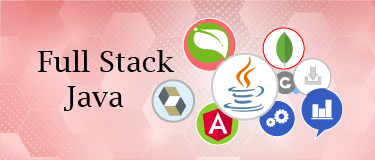
Java full-stack development is a versatile and rewarding career choice, combining the skills of front-end and back-end development with a deep understanding of databases and server management. If you’re looking to excel in this field, it’s essential to follow a structured approach to learning and skill-building.
This blog highlights five critical steps to becoming a proficient Java full-stack developer and tips for thriving in this competitive industry.
1. Understand the Core of Java Full-Stack Development
Before diving into the technologies, it’s important to understand what Java full-stack development entails.
Full-Stack Role: A full-stack developer works on the entire application lifecycle, from user interface design to database integration and server management.
Key Technologies: Core Java, Spring Boot, Angular, React, MySQL, and REST APIs are the backbone of this field.
Applications: Java full-stack developers create enterprise-grade applications, e-commerce platforms, and cloud-based solutions.
This understanding will help you build a clear learning roadmap.
2. Learn and Master Essential Technologies
Java full-stack development requires expertise in the following technologies:
Front-End Development
Languages: HTML, CSS, and JavaScript for building responsive interfaces.
Frameworks: React or Angular for dynamic front-end applications.
Back-End Development
Java: Learn core concepts like OOP, collections, and multithreading.
Spring Boot: Master this framework for building scalable and secure APIs.
Databases
SQL: Understand relational databases like MySQL and PostgreSQL.
NoSQL: Learn MongoDB for unstructured data management.
Version Control and Deployment
Git: Track and manage code changes.
CI/CD Tools: Use Jenkins and Docker for automating deployments.
3. Build Real-World Projects
Practical experience is crucial for becoming job-ready. Start by working on small projects, and gradually take on more complex ones. Some ideas include:
E-commerce Website: Build a shopping platform with product listings, a shopping cart, and payment gateway integration.
Social Media Application: Create a platform for posting, commenting, and interacting with other users.
Inventory Management System: Develop a tool for businesses to track and manage stock levels.
These projects will showcase your skills to potential employers and strengthen your understanding of full-stack development.
4. Explore Certifications and Training Programs
Earning certifications or completing professional courses can accelerate your learning and boost your credibility. Here are some excellent programs to consider:
Professional Full Stack Developer Certificate by IBM
Duration: 6 months
Focus: Hands-on projects, cloud integration, and API development.
Java Full Stack Developer Program by Great Learning
Duration: 8 months
Highlights: Industry mentorship, career support, and real-world projects.
Spring Framework Mastery by Pluralsight
Duration: Self-paced
Topics: In-depth Spring Boot, Spring Security, and microservices.
These programs provide structured learning, project experience, and industry-recognized credentials.
5. Develop Soft Skills for a Full-Stack Career
Being a successful Java full-stack developer is about more than technical skills. Companies value developers who excel in:
Problem-Solving: Analyzing complex requirements and designing efficient solutions.
Collaboration: Working effectively with teams, including designers, product managers, and testers.
Adaptability: Staying updated with new tools and technologies.
Communication: Clearly explaining technical concepts to stakeholders.
Soft skills, combined with technical expertise, make you a well-rounded professional.
Conclusion
Java full-stack development offers a fulfilling and dynamic career path, but success requires continuous learning and dedication. By mastering essential technologies, building real-world projects, and investing in professional training, you’ll be well-equipped to tackle the challenges of this exciting field.
Are you ready to start your journey? Choose a roadmap that fits your goals and take the first step toward becoming a proficient Java full-stack developer today!
0 notes
Text
Java Full Stack Developer Classes In Pune | 100% Placement. Giri's TechHub is most like Classes In Pune for java full stack developer, we provide IT Courses In Pune With 100% Placement Support, Call for Details : +91 9175444433.
#full stack developer#full stack java developer course#it training courses#IT classes in pune#java clsses in pune#Java full stack developer#C#C++#Java#java developers#technology#software#javascript#java development company#developer#java course#coding
0 notes
Text
“Unleashing Potential: Mastering Java Full Stack Developer Training”

Elevate Your Skills with Java Full Stack Developer Training In the fast-paced realm of tech, mastering Java Full Stack Developer training in Bangalore opens doors to limitless possibilities. Let’s embark on a journey to discover the key aspects of this dynamic training, propelling you into the world of full-stack development expertise.
Unveiling the Core: Java for Full Stack Development Java, the backbone of full-stack development, forms the foundation of your training. Dive deep into the world of Java programming, mastering its syntax and functionalities. This training equips you with the prowess to seamlessly transition between front-end and back-end development.
Navigating Back-End Marvels: Spring and Hibernate In the back-end universe, Spring and Hibernate emerge as your trusty allies. Explore the versatility of Spring for building robust applications, while Hibernate simplifies data management. Unleash the power of these frameworks to enhance the efficiency and scalability of your projects.
Crafting Responsive Front-End Experiences A Full Stack Developer’s arsenal is incomplete without front-end mastery. Embrace HTML, CSS, and JavaScript to sculpt visually stunning and responsive interfaces. Whether it’s Angular or React, incorporating these front-end frameworks elevates your web development game.
Database Wizardry: MySQL, Oracle, or MongoDB Dive into the world of databases, where MySQL, Oracle, or MongoDB become your playground. Java seamlessly integrates with these databases, allowing you to skillfully manage, retrieve, and optimize data. Unearth the secrets of data modeling and ensure your applications run like well-oiled machines.
Collaboration Tools and Version Control: Git and GitHub Effective collaboration is the cornerstone of successful development. Harness the power of Git for version control, ensuring seamless teamwork. Take your collaboration to the next level with GitHub, a platform that facilitates streamlined code sharing and project management.
Testing Triumphs: JUnit and Quality Assurance Quality assurance is non-negotiable in the world of Full Stack Development. Explore the realm of JUnit for rigorous testing of your codebase. Uphold the highest standards of quality, ensuring your applications not only meet but exceed user expectations.
Deployment Dynamics: Jenkins and Docker The final frontier in your training journey is deployment. Navigate the intricate landscape with tools like Jenkins and Docker, streamlining your deployment process. Witness your applications seamlessly transition from code repositories to live servers.
Continuous Learning As a Full Stack Developer, your journey is a perpetual odyssey of learning. Stay ahead of the curve by embracing emerging technologies within the Java ecosystem. The landscape evolves, and your commitment to continuous learning ensures you remain at the forefront of innovation.
Building Your Portfolio: Showcasing Mastery Your journey culminates in building an impressive portfolio. Showcase the projects you’ve passionately crafted during your Java Full Stack Developer training. Let your portfolio become a testament to your skills and a gateway to exciting opportunities.
Conclusion: Mastery Unleashed In conclusion, Java Full Stack Developer training is not just a program; it’s a transformative journey. From mastering Java’s intricacies to deploying applications seamlessly, you emerge as a versatile developer ready to conquer the dynamic world of full-stack development. Elevate your skills, craft your destiny, and thrive in the ever-evolving tech landscape.
Read More Courses
Spring Boot Microservices training
Python Full Stack Developer Training
Dot net full stack Training
Flutter training in Bangalore
#java full stack developer#java full stack training#core java online training#prakalpana technologies
0 notes
Text
#full stack developer#full stack developer course#java full stack developer course#java full stack developer#full stack course
1 note
·
View note
Text
Skills Required for Java Backend Developers
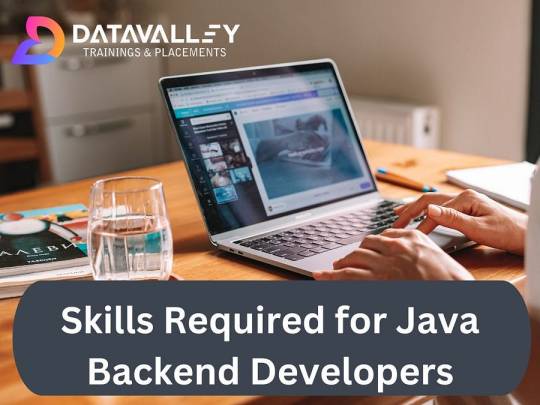
The backend developers are commonly known as the backbone of web development. The software aspect of a website is designed, modified, and repaired through back-end development. A skilled professional in backend web development creates the features that a user interacts with indirectly through a front-end of the application. Backend web development is a thriving profession that requires skilled professionals. Let’s look into the skills required for this role.
Java Programming
Java is a programming language used by backend developers to design application logic and rules. These experts must have great Java skills because it helps them to create complicated software programs. A background in Java can help you obtain work as a backend developer, particularly if your firm frequently uses this platform.
Knowledge of Java Frameworks
Java provides a wide range of frameworks that facilitate and accelerate backend development. Two highly notable frameworks are Spring and Spring Boot. It is essential for a Java backend developer to possess a deep understanding of these frameworks and grasp their fundamental principles. Spring offers extensive assistance in constructing enterprise applications, whereas Spring Boot simplifies the creation of independent, production-ready applications. Hibernate is another crucial framework that handles object-relational mapping, thereby enhancing the interaction with databases. Furthermore, Java EE (Enterprise Edition) presents a set of specifications and APIs for constructing scalable and distributed enterprise applications.
Database Management
Efficient management of data is a key duty for backend developers. Java backend developers must have a solid comprehension of SQL and NoSQL database systems. SQL databases, including MySQL, PostgreSQL, Oracle, and Microsoft SQL Server, are used for structured data. NoSQL databases like MongoDB, Cassandra are used for managing unstructured and semi-structured data. Proficiency to create, modify, and optimize database schemas is required. As the development of queries, were crucial for data-driven applications.
API Development
A Java backend developer must have the essential skill of designing, building, and consuming APIs. API stands for Application Programming Interface. APIs act as connectors between various system components, enabling communication and data sharing. It is crucial for Java developers to comprehend the principles of REST and SOAP web services and implement them. Well-documented, APIs are essential for seamless integration with frontend apps and third-party services.
Web Services and Data Formats
Java backend developers should have a strong understanding of web service technologies. They have to be proficient on the used data formats in web applications. Familiarity with JSON and XML is vital for facilitating data exchange between different systems. A good knowledge of HTTP and its methods like GET, POST, PUT, DELETE is essential. It is helpful in managing communication between clients and servers.
Version Control
As a Java backend engineer, you must be familiar with the version control software Git. This is because it is conventional for businesses to use this tool while developing applications. It enables them to trace changes and revert to prior versions if necessary.
Unit Testing
JUnit is a testing framework that allows developers to write automated code tests. Knowing JUnit can assist backend developers check the quality of their code and discover any problems before they deploy it. It also assures that the code continues to perform as intended following updates or changes, which can save time while debugging.
Understanding of MVC Architecture
Many web applications are designed following the Model-View-Controller (MVC) architectural pattern. Java backend developers should have a good understanding of this pattern, which separates an application into three interconnected components:
Model: Represents the data and business logic.
View: Displays the data and handles user interfaces.
Controller: Manages the interactions between the model and view.
MVC promotes code organization, reusability, and maintainability.
Build and Deployment Tools
Java applications are frequently developed and implemented using specialized procedures and tools. The compilation and packaging of Java code are made more efficient by build automation tools like Maven and Gradle. To automate the testing and deployment process, deployment tools like Jenkins or Travis CI are utilized, ensuring that code modifications are smoothly integrated into production environments.
Dependency Injection and IoC
Dependency Injection (DI) and Inversion of Control (IoC) are crucial concepts in Java development, particularly in the context of frameworks like Spring. Java backend developers should understand how DI and IoC work to achieve loose coupling between components and create modular, maintainable code.
Microservices Architecture
Microservices architecture is a design approach that entails constructing an application using small, autonomously deployable services. Familiarity with this architecture is crucial for Java backend developers, given its growing popularity in the development of scalable and distributed systems. While microservices provide advantages such as flexibility and ease of scaling, they also pose challenges in terms of coordination, data consistency, and inter-service communication.
Web Servers and Application Servers
Java applications are deployed and served on web servers and application servers. Familiarity with web servers like Apache or Nginx is essential. Knowledge of application servers such as Tomcat, WildFly, or WebSphere is must for the successful deployment. It is vital to comprehend the functioning of these servers, their configurations. It ensures optimization techniques required to tailor them for specific applications.
Caching Mechanisms
Caching stores frequently accessed data in memory to improve performance. Java backend developers should possess knowledge of caching mechanisms such as Redis, Memcached, or in-memory caches. In order to implement data caching and augment application responsiveness, it is required.
Message Queues
Message queues, such as RabbitMQ and Apache Kafka, have a crucial role in the development of asynchronous and distributed systems. It is imperative for Java backend developers to possess a comprehensive understanding of integrating and utilizing message queues. This understanding enables them to facilitate event-driven communication, enhance scalability, and ensure fault tolerance within their applications.
Agile Methodologies
The software development industry widely employs Agile methodologies like Scrum and Kanban to manage projects. Java backend developers should be comfortable working within Agile teams, participating in sprint planning, stand-up meetings, and retrospectives. Agile practices emphasize collaboration, adaptability, and delivering value to customers.
Problem-Solving Skills
Effective problem-solving skills are crucial for Java backend developers. Debugging and troubleshooting are regular tasks in software development. The capability to analyze issues, identify root causes, and execute solutions is vital for maintaining a robust backend system.
Soft Skills
In addition to technical skills, soft skills are also crucial for Java backend developers. Communication, teamwork, and collaboration are essential when working with front-end developers, quality assurance engineers, product managers, and other team members. Effective communication ensures that project requirements are understood and that development progresses smoothly.
Java backend development is a multifaceted discipline that requires a broad range of skills. Staying up-to-date with emerging technologies, best practices, and industry trends is essential in this dynamic field. Developing a strong skill set in the areas mentioned above will not only make you a valuable asset to your team but also equip you to tackle the challenges of modern software development.
If you’re looking to start your career in the world of Java full stack development, we invite you to join our comprehensive Java Full Stack Course at Datavalley. Our program is designed to equip you with the essential skills and knowledge required to excel as a Java full stack developer.
Attend Free Bootcamps
Looking to supercharge your Java skills and become a full-stack Java developer? Look no further than Datavalley’s Java Full Stack Developer bootcamp. This is your chance to take your career to the next level by enhancing your expertise.
Key points about Bootcamps:
It is completely free, and there is no obligation to complete the entire course.
20 hours total, two hours daily for two weeks.
Gain hands-on experience with tools and projects.
Explore and decide if the field or career is right for you.
Complete a mini-project.
Earn a certificate to show on your profile.
No commitment is required after bootcamp.
Take another bootcamp if you are unsure about your track.

#datavalley#dataexperts#data engineering#data analytics#dataexcellence#business intelligence#data science#power bi#data analytics course#data science course#java developers#java full stack bootcamp#java full stack developer#java full stack course#java full stack training#java#full stack course#full stack training#full stack web development#full stack developer#full stack software developer
1 note
·
View note